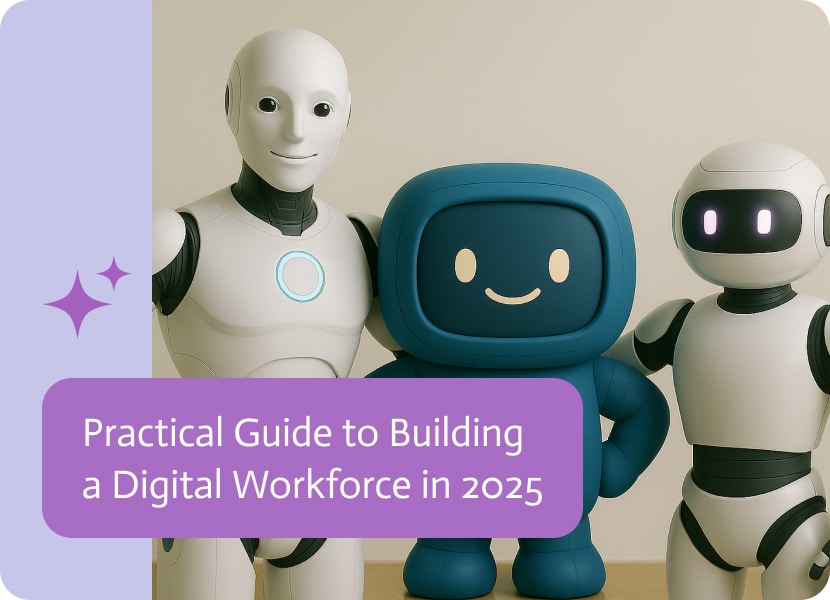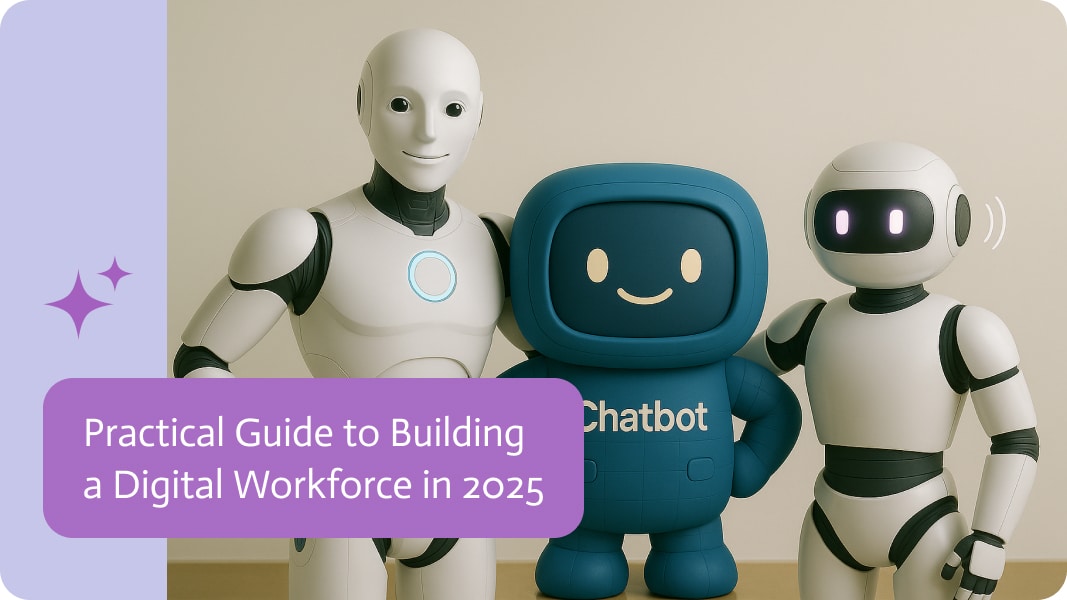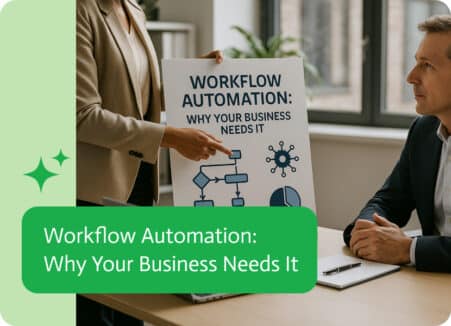

Digital Workforce Building in 2026
The conversation around automation has shifted dramatically. In 2025 already, we’re no longer talking about simple chatbots or rule-based scripts. The new frontier is a digital workforce, made up of AI employees capable of handling entire business processes from start to finish. These aren’t assistants waiting for prompts; they’re autonomous bots that are able to comprehend goals, plan steps, take action, and even know when to call for human help.
In all different industry types, companies are beginning to deploy these “AI employees” to process invoices, onboard customers, manage HR workflows, and run back-office operations that once demanded entire teams. But building a digital workforce isn’t as simple as adding AI to your company, you need the right setup, data ready to go, clear rules, and a good plan for how to roll it out.
Let’s unpack how a modern company can actually build a digital workforce and how a platform like Noca can help make it real.
From Basic Bots to Digital Workforce
Traditional automation tools, RPA bots, macros, and scripted APIs were okay for doing the same things over and over but were blind to context. A digital employee, by contrast, is goal-driven. It receives an objective (“validate and pay this invoice”) and figures out the steps needed from reading the file to extracting values, checking business rules, posting to the ERP, notifying accounting, and logging the outcomes.
These new workers are built around agentic AI, wherein LLMs and smaller domain-specific models collaborate inside an orchestration framework. Instead of one rigid script, you have multiple specialized sub-agents, like document parsers, data validators, connectors, communicators, coordinated by a central planner that manages sequence, retries, and exceptions.
Noca’s orchestration layer can coordinate agents across finance, HR, and customer service, allowing you to design an entire digital workforce that behaves like a cohesive team.
The Modern Digital Workforce Architecture
Under the hood, a functional digital employee depends on several connected components.
On top is the task or goal interface, where a person or system gives the agent an assignment. Next comes the orchestration engine, the brain that interprets that request and coordinates sub-agents. Beneath it are the execution agents that actually do the work: parsing, validation, writing, or sending communications.
Supporting these are integration layers that connect to your ERP, CRM, and databases, sometimes via APIs, sometimes through RPA bridges for older software. A context store maintains state (what’s done, what’s pending), while a model layer supplies LLMs for classification, summarization, or decision-making.
Finally, observability and governance wrap around it all: logging, metrics, audit trails, approval gates, and the setting up of access for trust.
Noca fits right at the center, offering the orchestration, monitoring, and governance so all those moving parts behave as one system. Instead of managing a spaghetti of scripts, Noca lets you visualize, control, and scale your digital employees through a unified dashboard.
The Journey from Pilot to Scale
Building a digital workforce happens in stages, not leaps. The smartest companies will start out smaller and then slowly grow.
1. Strategy and Pilot Selection
Begin with intent. Identify two or three processes that are clear, repetitive, and measurable. You want workflows with clear instructions and outcomes, like claims processing, invoice reconciliation, or employee onboarding. Set baselines: current cost, error rate, and processing time. That’s your control group for future ROI.
2. Process Discovery
Interview subject-matter experts, record each move, and capture rules and exceptions. Build a “process vault,” a central record of data fields, integrations, and decision logic. It’s the blueprint your digital employee will follow.
3. Data and Access Readiness
Before you even think of writing any code, be certain your systems can communicate and the info is reliable. Any connections should be authenticated and stable. Where older software is being used, prepare RPA bridges. Fix inconsistent data as soon as possible because agents can’t reason around bad inputs.
4. Building the Agent Bundle
Develop modular components: one to read the input, one to check the data, one to enter the results, and one to send updates. Integrate them under your orchestration layer (like Noca). Run simulations on historical data until the results are as good as what a human would do.
5. Monitoring and Safety
Deploy with supervision. High-impact events require approval gates; medium-risk jobs can be automatically run but log every step. Build dashboards for supervisors to review decisions, view context, and override or retrain agents as needed. Trust builds when people can see what the agent sees.
6. Continuous Schooling and Growth
Once the pilot works, start monitoring performance. Measure throughput, accuracy, and escalation rates. Analyze whenever you think a person should intervene and teach the agent how those scenarios should be managed next. Eventually, you’ll accumulate reusable modules, a shared library of agent “skills.”
As the number of digital employees grows, you’ll need a platform approach: centralized governance, standardized pipelines, and consistent observability. Noca can act as that foundation, ensuring all agents follow the same playbook for logging, privacy, and compliance.
Digital Workforce Governance and Safeguards
Deploying AI employees at scale means embracing accountability. A digital workforce touches real money, data, and people, so governance must be built in from day one. Start by classifying processes by risk level. Low-risk agents can act autonomously; high-risk ones need human review or tighter oversight.
Each decision an agent makes should be traceable, like what data it saw, which model it used, and why it made that call. Store this lineage for audits and debugging. Maintain which version of the model was used, so you always know which model made which decision. Contracts with outside service providers should specify data residency, how clear the models are, and rollback rights. If an update changes behavior, you must be able to revert safely.
Finally, bake ethics into everyday processes. Give compliance, security, and HR teams a voice early in design meetings. This is to ensure you build something sustainable and auditable, not a shadow system no one understands.
Measuring Success of Your Digital Workforce
A digital workforce earns its keep through real-world results. The clearest metrics are speed, reliability, and price tag, but subtler benefits often matter just as much.
Track cycle time, like how long it takes to do a job, error rate, human escalation volume, and the cost per action before and after starting to use digital employees. Figure out the profitability zone where automation investment starts paying back. Monitor model drift, agent uptime, and recovery time after failures.
Keep an eye open for cultural shifts. Employees freed from repetitive work usually speak of better engagement. Customer responses become faster, compliance improves, and backlogs shrink. Digital employees don’t just replace workers, they change how people work.
Avoiding Common Mistakes
The biggest failure mode in digital-worker projects is assuming it’s purely a technical problem. In truth, it’s an organizational transformation. Without executive sponsorship, clear roles, and change management, even brilliant engineering won’t scale.
Another problem is weak data systems. Agents are only as smart as the information they get. Unstable connections or bad data will hurt even the best system.
Finally, don’t skip transparency. When workers can’t see what agents do, or worse, when something goes wrong without explanation, trust evaporates. Provide dashboards, logs, and explainability from day one.
Here again, Noca can serve as your safety net. Its built-in observability, human-in-the-loop approvals, and error dashboards let humans stay in control while agents handle the grunt work.
What’s Coming Up
As 2025 progresses, enterprises are maturing from “AI experiments” to AI-operated workflows. Automation vendors are rolling out agent setups, and forward-looking companies are creating internal “digital-worker teams” dedicated to the design and management of AI employees.
The trend is clear: soon, your organization’s employee directory may include both digital colleagues in tandem with people, each with roles, duties, and supervisors. Rather than competing with humans, digital employees complement them, handling structured, repetitive work while people focus on being creative and relationship-building.
Platforms like Noca will anchor this evolution, giving businesses a control layer to deploy, monitor, and govern hundreds of digital employees. The result is a workplace that operates 24/7, scales on demand, and continuously learns.
Building Your Digital Workforce With Noca AI
Noca lets you describe what your business needs, then it understands and instantly delivers the right solution, whether it’s an app, an automation, or your very own digital employee.
Here’s what that looks like in practice: You describe your app in plain English, and AI instantly builds the interface, rationale, and even the links. You can tweak it at any time with simple, conversational prompts. Need an employee feedback tracker? Just describe it. Want to build a custom access management tool? Tell Noca what you want. Noca uses NLP to comprehend what you want and builds from there.
The result? Businesses typically see results from this approach in just weeks, with faster development, fewer errors, and streamlined delivery, which automatically leads to substantial ROI almost immediately.
Integration capabilities are when Noca flexes its muscles, because the platform was built with enterprise integration as a core feature, not a mere afterthought. Noca offers bidirectional integrations with CRMs, ERPs, or basically any enterprise system, and ensures that every app follows the TRAPS framework, delivering enterprise-grade compliance out of the box.
Noca connects over 500 applications and services like ERP, CRM, marketing tools, e-commerce platforms, and more with AI Agent Orchestration that deploys digital employees, automating processes spanning various systems, monitoring data, and carrying out proactive measures autonomously.
Noca features auto-scaling, performance tuning, and fault tolerance built in, so your app stays fast and reliable as usage grows. This isn’t accidental, it’s by architectural design.
Noca provides full visibility and control through an intuitive interface to track every process, monitor flow health, and remedy any issues with ease, with real-time adaptation so digital employees can adjust workflows live, which means your integrations keep up with real-time changes.
Safety definitely wasn’t an add-on, as every app follows Noca’s TRAPS framework: Trusted, Responsible, Auditable, Private, and Secure, delivering enterprise-grade compliance out of the box. This isn’t optional add-on security; it’s baked into every digital employee from the get-go.
Conclusion
Building a digital workforce isn’t just to get rid of hardworking humans but more about redesigning how work gets done. Success demands as much attention to governance and process as it does to technology.
Start small, measure everything, and plan for transparency. Pick tools that focus on security and monitoring. Treat your digital employees as part of the team. Train them, check them, and help them improve.
With the right foundation, a platform like Noca can turn the idea of autonomous AI employees into an operational reality, an integrated, intelligent workforce that doesn’t just execute tasks but delivers outcomes.
The companies that get this shift right won’t just automate; they’ll reinvent how work itself happens.


